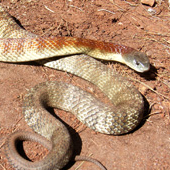The Great Outback is known not only for its teeming and varied wildlife, but also for the large population of exotic and venomous animals. One of the most common is Australia’s diverse population of snakes. While not all snakes are dangerous, there are a large number of venomous snakes dispersed throughout the country, and lack of education is one of the main causes of fatalities. Here is a quick guide to Australia’s top non-venomous and venomous snakes.
Australia’s Top Venomous and Non-venomous Snakes
The Venomous List:
1. Eastern and Western brown snakes (Pseudonaja textilis and Pseudonaja nuchalis, respectively) – called the common brown snake and the gwardar respectively, the Eastern and Western brown snakes are among the most widespread snakes throughout much of mainland Australia.
The common brown snake is known for its very potent venom, aggressiveness and ferocity. Able to render a grown human dead in less than an hour, its venom contains neurotoxins that cause paralysis. It contains anticoagulative compounds that thin out the blood, making it quite difficult to treat with antivenom. The gwardar , though by and large less aggressive than the common brown, injects triple the dose of venom into a victim, making them extremely dangerous.
2. Mainland tiger snake (Notechis scutatus) – with a habitat encompassing much of south-eastern and South Australia, to as far as Tasmania, Victoria, and New South Wales, the mainland or common tiger snake, known for their banded, ragged stripes and striking yellow to yellow-black colouration, is notorious for their fatal bite. Causing muscular paralysis, swelling, and acute pain, its venom causes renal failure if left untreated.
3. Coastal taipan (Oxyuranus scutellatus) – commonly called the ‘eastern taipan’ this snake is known for its extremely wary and sensitive temperament, as well as for its unexpected ferocity and lighting-fast speeds. Thankfully, the eastern taipan would much rather avoid biting, although there are always exceptions to this rule.
The venom directly affects the nervous and circulatory system, causing instantaneous internal bleeding, muscular degeneration, nausea, severe convulsions, and eventual renal failure. The bite from an eastern taipan is enough to kill an adult human in less than thirty minutes.
The Non-venomous list:
1. Green Tree Snake (Dendrelaphis punculata) – this non-venomous snake is quite commonplace in Australia, and can be found in areas where there is thick vegetation. Known for its olive-green to blackish colouration, it may display pale hues of yellow and white on its throat, belly, and throughout its body. Although very timid and shy, the snake will nevertheless bite when provoked, and while the bite itself is nonlethal, it nevertheless leaves a nasty sting.
2. Carpet Python (Morelia spilota) – found all throughout urban areas, commonly in Sydney, Melbourne, Perth, Brisbane, Adelaide and Darwin, these snakes are known for their capacity to grow very large in size, and is known for its unassuming black, brown, steel-grey and iron ‘camouflage’ colouration.
Carpet pythons have a habit of living in places where they feel safe or comfortable, and that is why they are often found in residential areas. Although it is perfectly harmless, it can bite if provoked or threatened. The rows of serrated teeth in its mouth can leave a nasty open wound that may become infected if left untreated.
3. Children’s python (Antaresia children) – as the name suggests, this small brown-tan mottled python is relatively even-tempered and good-natured, and makes for ideal pets for young adults and children. It is a non-venomous pet that will make for a good, slithery friend for years to come, with a lifespan of up to thirty years if well cared-for. Although its name suggests it as an ideal pet for children, it is actually named in honour of its discoverer, John George Children.
Snakes, whether the venomous or the non-venomous sorts, are amazing creatures that have as much a right of being where people are as people do. While it cannot be denied that some snakes comes equipped to kill, given that one understands that these creatures require space, deserve respect, and will most often choose to leave than fight if confronted, one may come to a greater appreciation of these misunderstood wonders of nature.
For more information on snakes, their care, behaviour and habits, please visit: www.blacksnakeproductions.com.au

